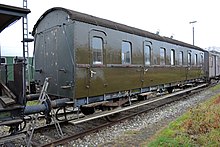Fox wagon factory
The Waggonfabrik Fuchs (Wagen-Fabrik H. Fuchs) in Heidelberg manufactured rail vehicles, bridges and other railway equipment from 1862 to 1957, but mainly railway cars and trams .
history
The wagon factory founded by Johann Schäfer in Heidelberg in 1844 south of the main train station in Weststadt was sold to Heinrich Fuchs after his death in 1861 , who founded the Heinrich Fuchs wagon factory on April 2, 1862 . Also in 1862, the Hartmann & Lindt wagon factory was taken over, which from 1845 had built a locomotive for the Baden State Railways in Heidelberg's old town .
After the death of Heinrich Fuchs, his son Karl Fuchs took over the company in 1884. The city of Heidelberg only approved an extension by two new factory halls in 1897, as they wanted to move it. Due to the planned relocation of the main train station, the factory was relocated to the then neighboring town and today's district of Rohrbach on a 14 m 2 area at the local train station by 1902 . The conversion to H. Fuchs Waggonfabrik AG Heidelberg took place in 1899. At that time the company had around 800 employees. In addition to railway cars, bridges and other parts for railway systems were also built in the early days . The Baden State Railways were the main buyers of the wagons until the First World War . In addition, other state and private railways were also supplied.
Production of trams began around 1901. Customers included the electric streetcar Heidelberg Wiesloch , Heidelberger road and mountain railway (HSB), Upper Rhenish Railway Company (OEG), Rhein-Haardtbahn (RHB). Also, underground trains for the Berlin underground as well as the Glass train are delivered. A "highlight" for the factory was the construction (at least some of the wagons) of Hermann Göring's personal special train , whose interior was built using the finest exotic woods that could be obtained (e.g. rosewood and very rare types of mahogany). The most expensive was just good enough, and the workers proudly worked on these opulent wagons.
The company went public in 1908.
Fuchs survived the First and Second World Wars only with great losses, and almost all workers had to be laid off or operations stopped several times . After the war, the company had around 1200 employees and lost half of its employees in 1925. In some cases, attempts were made to switch to other products such as articulated lorries or excavators , but this brought little success.
From 1919 to 1922 several new workshops were built for the construction of passenger coaches with steel car bodies.
In 1921, Fuchs became a member of the Eisenbahnwagen Liefergemeinschaft GmbH (EISLIEG) in Düsseldorf together with the wagon construction company Dessauer Waggonfabrik AG , Düsseldorfer Eisenbahnbedarf, formerly. Carl Weyer & Co. , Siegener Eisenbahnbedarf AG, Waggon-Fabrik AG Uerdingen and Wegmann & Co., Kassel . WUMAG ( Waggon- und Maschinenbau AG , Görlitz) and Gottfried Lindner AG (Ammendorf) also joined the group later . With an annual production capacity of 18-20,000 vehicles, this wagon construction group was the largest and most efficient group within the German wagon construction industry.
With the help of the Waggonfabrik Gebr. Schöndorff , insolvency of the company was prevented in 1929. At the end of August it again had five times the number of approximately one hundred employees that were still available at the beginning of 1929.
The 1930 by the Association of West German Waggonfabriken majority of shares acquired (West wagon) was the 1940 Dillinger Hütte sold, because of their location in the Saarland 1957, the shares of Fuchs to obtain foreign currency to the International Harvester Company sold the production of combine harvesters Ground surrounded. In 1983 the factory was sold to Dresser Europe SA, and in 1989 to the Furukawa Group . In 1995 production in the Rohrbach plant was stopped and it was only used as a distribution warehouse. In 2001, the “Quartier am Turm” housing estate was built on a plot of around 100,000 square meters in the former Fuchs wagon factory.
In Heidelberg-Rohrbach , a street from the factory to the center was named after Heinrich Fuchs.
swell
- Bernhard König: Rail vehicle construction in Heidelberg. On the website of Eisenbahnfreunde Heidelberg e. V. http://www.ef-heidelberg.de
- Bernhard König: The Heinrich Fuchs wagon factory in Heidelberg. In: Bundesverband Deutscher Eisenbahnfreunde eV yearbook. 1990, ZDB -ID 628687-2 , pp. 126-137.
- Hans-Erhard Lessing : Railcar design from Heidelberg. The H. Fuchs Waggonfabrik AG. In: Peter Blum (ed.): Pioneers from technology and economy in Heidelberg (= series of publications of the Heidelberg City Archives. Special publication. Vol. 12). Shaker, Aachen 2000, ISBN 3-8265-6544-4 , pp. 26-41.
- Developer Epple Immobilien ( http://www.eppleimmobilien.de ): From the wagon factory to new living space. On the website of the property developer for the new quarter at the tower. http://www.quartier-am-turm.de
Web links
- Former Fuchs wagon factory on the website of the Rhein-Neckar-Industriekultur association
- Early documents and newspaper articles on the Fuchs wagon factory in the 20th century press kit of the ZBW - Leibniz Information Center for Economics .
Individual evidence
- ↑ a b c d e f g h i j k l m n o http://www.kastenlok.de/efh/fzbau/hauptteil_fzbau.htm
- ↑ http://www.s197410804.online.de/Personen/FuchsHsen.htm
- ^ The German railway system of the present, Hobbing Verlag Berlin, edition 1923, page 480 ff.
- ↑ www.conceptaplan.de
- ↑ capital.de : Real Estate Compass
Coordinates: 49 ° 22 ′ 55 " N , 8 ° 40 ′ 37" E




